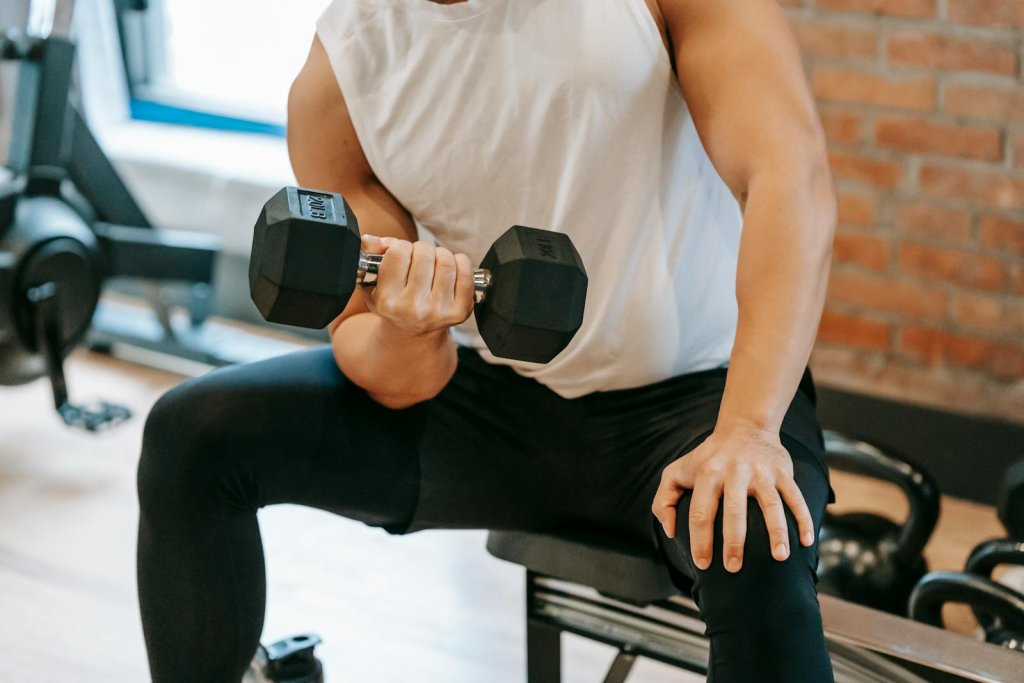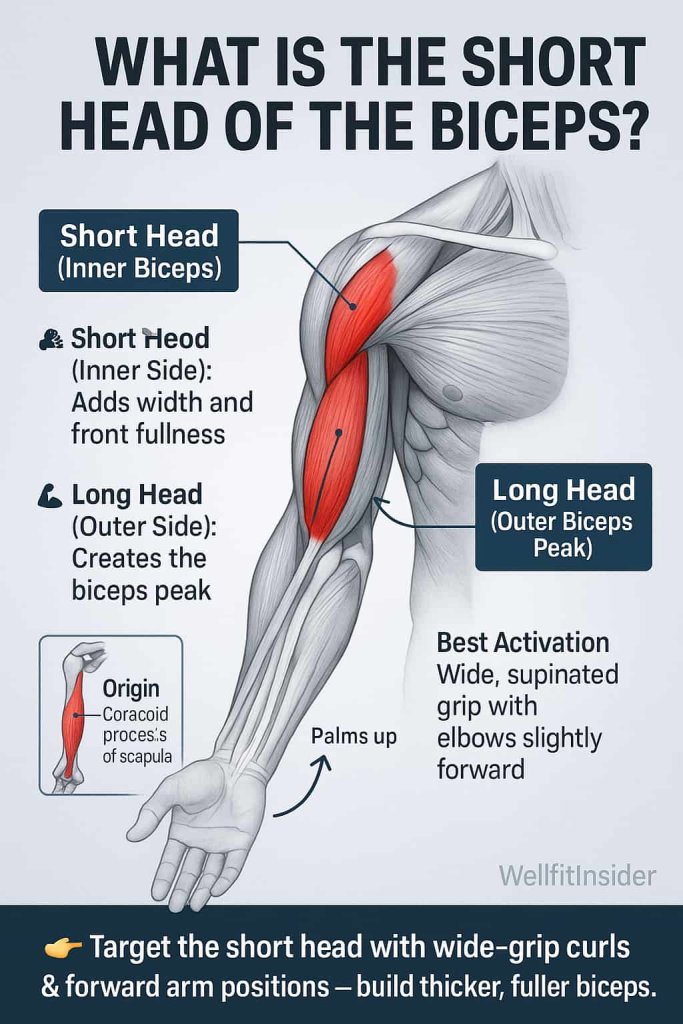The short head of the biceps helps give your arms that full, thick inner look — and yes, you can target it with specific grip angles and movements.

If your goal is to build bigger, more balanced arms, learning how to train the short head of the biceps is essential. This guide covers anatomy, top exercises, form cues, and training tips — all backed by science and leading fitness experts.
What Is the Short Head of the Biceps?
The biceps brachii has two parts:
- Short head – inner side, visible from the front when flexing.
- Long head – outer side, forming the “bicep peak.”

The short head originates from the coracoid process of the scapula and runs down to the forearm. It’s most active when your elbows are in front of your body or when using a wide, supinated (palms up) grip.
👉 Goal: Use exercises that keep your elbows slightly forward and grip wider than shoulder width to emphasize the short head.
15 Best Short-Head Bicep Exercises
Below are the 15 most effective exercises to target the inner head of your biceps, build width, and achieve that fuller arm look.
1. Wide-Grip Barbell Curl
Why it works:
A wider grip externally rotates your shoulders, shifting emphasis onto the inner (short) head of your biceps.
How to do it:
- Stand tall holding a barbell with a wide underhand grip (hands 6–8 inches outside shoulders).
- Curl the bar up slowly, keeping elbows close to your sides.
- Squeeze hard at the top, then lower under control.
Trainer Tip: Avoid swinging; keep tension constant through the entire range.
2. EZ-Bar Wide-Grip Curl
Why it works:
Similar to the barbell curl, but the angled grips reduce wrist strain while keeping the same wide-arm emphasis.
How to do it:
- Grab an EZ bar using the outer handles.
- Curl toward your shoulders and pause briefly at the top.
- Lower slowly until arms are fully extended.
Trainer Tip: Keep wrists straight and avoid shrugging shoulders.
3. Preacher Curl (Wide Grip or Dumbbell)
Why it works:
By locking your upper arms on the pad, the preacher curl isolates your short head and prevents momentum.
How to do it:
- Sit on a preacher bench, upper arms resting fully on the pad.
- Curl up slowly, squeezing the inner biceps.
- Lower until your arms are almost straight.
Trainer Tip: Keep elbows tucked in; don’t let them flare out.
4. Concentration Curl
Why it works:
Eliminates cheating and allows a deep squeeze at the top — a perfect finisher for the short head.
How to do it:
- Sit on a bench, legs apart.
- Rest elbow against inner thigh, palm facing up.
- Curl dumbbell toward shoulder, pause, then lower slowly.
Trainer Tip: Focus on mind-muscle connection — feel the contraction, not the weight.
5. Spider Curl
Why it works:
Because your arms hang in front of your torso, this exercise maximizes short-head tension throughout the motion.
How to do it:
- Lie chest-down on an incline bench, arms hanging straight down.
- Curl dumbbells up to shoulder level, pause, and lower slowly.
Trainer Tip: Keep shoulders fixed — let only your elbows move.
6. Cable High Curl (Overhead Curl)
Why it works:
Constant cable tension enhances short-head recruitment, especially during peak contraction.
How to do it:
- Set dual cables slightly above shoulder height.
- Hold one handle in each hand, palms facing up.
- Curl inward toward your ears, squeezing the biceps at the top.
Trainer Tip: Keep upper arms still — focus purely on elbow flexion.
7. Crucifix Curl (Cable or Bands)
Why it works:
With arms extended out to the sides, the short head is both stretched and contracted, producing a powerful pump.
How to do it:
- Stand centered between two cables set at shoulder height.
- Step slightly forward, arms extended like a crucifix.
- Curl handles toward your head, pause, then slowly return.
Trainer Tip: Avoid moving shoulders or leaning forward.
8. Zottman Curl
Why it works:
The supinated (palms-up) curling phase hits the short head; the eccentric (palms-down lowering) strengthens forearms.
How to do it:
- Curl up with palms facing up.
- At the top, rotate wrists to palms-down, then lower slowly.
Trainer Tip: Control every rotation — don’t rush transitions.
9. Seated Dumbbell Curl
Why it works:
Sitting stabilizes your torso, reducing momentum and isolating the inner head of your biceps.
How to do it:
- Sit upright with dumbbells at your sides, palms forward.
- Curl both arms simultaneously or alternately.
- Keep elbows slightly in front of your body.
Trainer Tip: Avoid leaning back or using your shoulders.
10. Cable Curl (Wide-Grip Straight Bar)
Why it works:
The cable’s continuous resistance ensures constant short-head tension throughout the motion.
How to do it:
- Attach a straight bar to a low pulley.
- Grip the bar wide, palms up.
- Curl smoothly toward your chest and lower under control.
Trainer Tip: Keep your wrists neutral and avoid jerky motions.
11. Wide-Grip Chin-Up (Underhand)
Why it works:
A compound move that develops biceps, forearms, and lats — with extra short-head activation from the wide underhand grip.
How to do it:
- Grab a chin-up bar underhand, wider than shoulders.
- Pull yourself up until chin clears the bar.
- Lower slowly under control.
Trainer Tip: Keep legs still; drive the motion from your arms and back.
12. Supine Cable Curl (Lying Curl)
Why it works:
Lying on your back eliminates shoulder involvement, allowing pure bicep isolation and constant tension.
How to do it:
- Lie flat on a bench with low-pulley handles in hand.
- Curl toward shoulders, pause briefly, then lower.
Trainer Tip: Keep elbows anchored near your ribs throughout.
13. Biceps 21s (Wide Grip)
Why it works:
Combining partial and full reps floods the short head with blood for maximum pump and growth.
How to do it:
- Perform 7 bottom-half curls, 7 top-half curls, and 7 full curls — all with a wide grip.
- Rest briefly between sets (30–45 seconds).
Trainer Tip: Use lighter weights — focus on volume and burn.
14. No-Money Curl (Athlean-X Style)
Why it works:
By rotating forearms outward, this movement enhances external rotation, which favors short-head activation.
How to do it:
- Stand tall with light dumbbells, elbows at 90°, palms up.
- Rotate forearms outward slightly (like showing your palms).
- Curl slightly upward while keeping elbows by your ribs.
Trainer Tip: Use very light weights; prioritize control and shoulder position.
15. Bayesian Cable Curl
Why it works:
Because your arm stays slightly in front of your body, the short head stays under continuous tension — perfect for isolation.
How to do it:
- Attach a single handle to a low cable.
- Step forward until the cable pulls slightly behind you.
- Curl forward while keeping your elbow just in front of your torso.
Trainer Tip: Don’t let your elbow drift backward — maintain that forward bias.
Programming Tips for Bigger Biceps
- Frequency: Train biceps 2–3× per week.
- Volume: 9–15 total working sets per week (mix both heads).
- Reps: 8–15 reps for hypertrophy.
- Tempo: 2–1–3 (lift–pause–lower) for maximum control.
- Grip variety: Alternate between wide and neutral grips.
- Mind–muscle connection: Focus on squeezing inner biceps at the top of every rep.
Common Mistakes to Avoid
- Swinging or using momentum
- Letting elbows drift back
- Overloading too heavy and losing control
- Neglecting the long head (train both for full arms)
Benefits of Targeting the Short Head
- Builds inner arm thickness and balanced shape
- Improves aesthetic symmetry between inner and outer arms
- Enhances arm flexion strength and stability
- Supports elbow joint control during compound lifts
Who Should Focus on Short-Head Training?
- Lifters whose arms look “flat” from the front
- Anyone aiming for rounder, fuller biceps
- Bodybuilders needing symmetrical arm development
- Fitness enthusiasts seeking complete arm training
Safety Tips Before Training
- Warm up 5–10 minutes (arm swings, light curls).
- Use proper posture; avoid shrugging shoulders.
- Control eccentric (lowering) phase to protect elbows.
- If you have elbow tendinitis or shoulder pain, reduce volume or use cables.
- Consult a trainer or physical therapist if pain persists.
FAQs About Short-Head Bicep Exercises
1. Can you isolate the short head of the biceps?
No — but you can emphasize it using wider grips and forward arm positions.
2. Is a wide grip always better for short-head training?
Yes, a slightly wider grip increases short-head activation, but not extremely wide.
3. How often should I train my biceps?
2–3 times per week is optimal for growth and recovery.
4. What’s the best rep range for biceps growth?
8–15 reps per set with controlled form.
5. Can beginners do short-head exercises?
Absolutely — just start with lighter weights and master technique.
6. Should I use cables or free weights?
Both! Cables maintain tension; free weights improve stability.
7. What’s the difference between short-head and long-head exercises?
Short head = inner biceps (wide grip, arms forward).
Long head = outer biceps (narrow grip, arms behind torso).
Conclusion
The short head of the biceps gives your arms that wide, front-facing fullness many lifters overlook.
Combine these 15 short-head bicep exercises with proper nutrition, progressive overload, and consistent form — and you’ll quickly see thicker, rounder arms.
